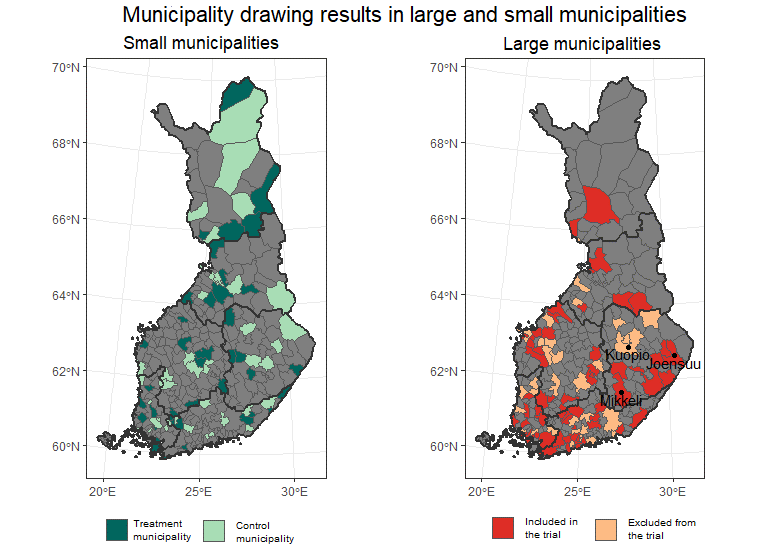How were the day-care centres of the two-year preschool education trial selected?

A unique trial on a longer period of preschool education is being carried out in Finland. In this article, we will talk about the background of the experiment and the methods employed to choose the day-care groups for treatment and control groups around Finland.

Kuva: BBC Creative / Unsplash
The Ministry of Education and Culture chose VATT to carry out a two-year preschool education follow-up study with Aalto University and the universities of Helsinki, Jyväskylä and Turku. The purpose of the two-year preschool education trial is to assess how an earlier start to preschool education affects a child’s educational ability. Qualities under review include literacy, numeracy, self-esteem and social skills.
The trial compares the learning differences of children who have undergone different lengths of preschool education in the beginning of their school lives. The children at the day-care centres in the treatmentgroup will begin preschool education one year sooner, at age five, in accordance with the two-year preschool education plan created for the test group. The control group are children who will receive ordinary childhood education or home care, and will begin preschool education at the regular age of six. In first grade, i.e. at roughly seven years old, the treatment group’s school skills are compared to those of the children in the control group.
How were the participating day-care centres drawn?
The participating municipalities and day-care centres were chosen by drawing lots. This is a so-called randomised field experiment, which means that selection into the test group is left to chance. We first examined how many municipalities had a eligible day-care centre. Eligibility was determined as being a day-care centre wherein the children can stay for early childhood education after their preschool education.
Initially, the municipalities were divided into two groups based on how many eligible day-care centres they were seen to have. The first group consists of small municipalities that have at least one but no more than four eligible day-care centres. There were a total of 85 eligible small municipalities. The second group were the large municipalities, in which there were five or more eligible day-care centres. There were 94 largemunicipalities. Both groups were subject to a separate drawing and in a slightly different manner to guarantee comparability.
Map 1. Municipalities with at least one eligible day-care centre.

Image: Municipalities that did not have any day-care centres suitable for the trial are shown on the map in grey. Suitability was determined as being a day-care centre wherein the children can stay for childhood education after their preschool education. The remaining municipalities were divided into large and small according to the number of eligible day-care centres in the area. Small municipalities were estimated to have 1-4 eligible day-care centres, and large ones would have five or more..
Small municipalities were split, to preserve regional representation, into strata based on their AVI region. After this, half of the municipalities in each stratum were placed in either the treatment group or the control group. In the drawing, an effort was made to make sure that similar municipalities were placed in both the treatment and control groups. With the smallmunicipalities, the comparison criteria that were used were the municipality’s average income level, education level and the proportion of foreign-language speakers. The test group included 42 small municipalities, and the control group included 43.
Map 2. Municipality drawing results in large and small municipalities.

Image: The map on the left shows the division of small municipalities into treatment and control municipalities. The division was done by drawing lots. The map on the right shows the large municipalities that were selected for the trial in red. The municipalities were selected by drawing lots. The ones in grey were left out of the trial for budgetary reasons. In the large municipalities marked in red, the day-care centres were further divided into the test and control groups by drawing lots. AVI region boundaries are shown in black.
Similarly, the 94 large municipalities were divided into smaller, regional drawing groups. In addition to the AVI region, the number of day-care centres was considered in the distribution of the drawing groups. For example, the municipalities in Eastern Finland with 20-50 eligible day-care centres comprise one drawing group with three municipalities (Joensuu, Kuopio, Mikkeli). As it was not possible to provide free two-year preschool education at all municipalities for budgetary reasons, only 63 of the large municipalities were included in the drawing phase.
With the large municipalities, the participating municipalities were drawn first, and then the day-care centres within the municipalities. First, 65% of the municipalities were drawn from each drawing group at random. After this, the day-cares from the large municipalities were drawn. Roughly 40% of each municipality’s eligible day-care centres were drawn into the treatment group. In the drawing, an effort was made to make sure that every municipality had similar day-care centres placed in both the treatment and control groups. The comparison criteria for similarity in the day-care centres was, therefore, the income and education levels of the day-care centres customer families, the share of single parents, and their language.
The difference between the large and small municipalities in this drawing was that for the small municipalities, the drawings were carried out on the municipal level, whereas for the largemunicipalities, the randomisation was carried out on the level of the day-care centres. With both, regional representation was guaranteed by dividing the groups in the AVI regions..
Selected municipalities and day-care centres
In the drawing, 42 small municipalities were selected for the two-year preschool trial. The selected small municipalities will arrange the preschool education trial for five-year-olds in all eligible day-care centres. The municipalities in the control groups will not change anything. In the large municipalities, only the day-care centres that were selected for the treatment group will arrange preschool education for five-year-olds in accordance with the trial curriculum. The day-care centres in the control group will continue to operate as before.
Table 1. The number of participating day-care centres and children in the trial in large and small municipalities.
| |
Large municipalities (63) |
Small municipalities (85) |
| |
Centres |
Children |
Centres |
Children |
| Test group |
297 |
5792 |
136 |
1974 |
| Control group |
453 |
8886 |
131 |
1701 |
| Total |
750 |
14678 |
267 |
3675 |
Figure: The figures in this table indicate how many day-care centres participated in the drawing and how many children were enrolled in said day-care centres at the time. The number of children shown in the table may differ from the actual number of children participating in two-year preschool education trial, as the children may move, change day care centres or otherwise transfer away from trial activities after the drawing..
The trial also included children in home care. Certain eligible children in home care living near a participating day-care centre at the time of the drawing (born in 2016) and were offered an opportunity for free two-year preschool education. Their control group was the children in home care living near day-care centres in the control groups. These children are included in the Table 1 figures. Family day care and group family day care were excluded from the trial.
Further information:
Senior Researcher Ramin Izadi, VATT Institute for Economic Research, [email protected]
Assistant professor Matti Sarvimäki, Aalto University and VATT Institute for Economic Research, [email protected]
More information on the two-year preschool education trial is available on the website of the Ministry of Education and Culture.
Matti Sarvimäki
Ramin Izadi
Blog
Blogit
Education
Labour markets and education
education and training
elementary schools
learning outcomes
municipalities
regionalization
school institutions
school quality
skills

